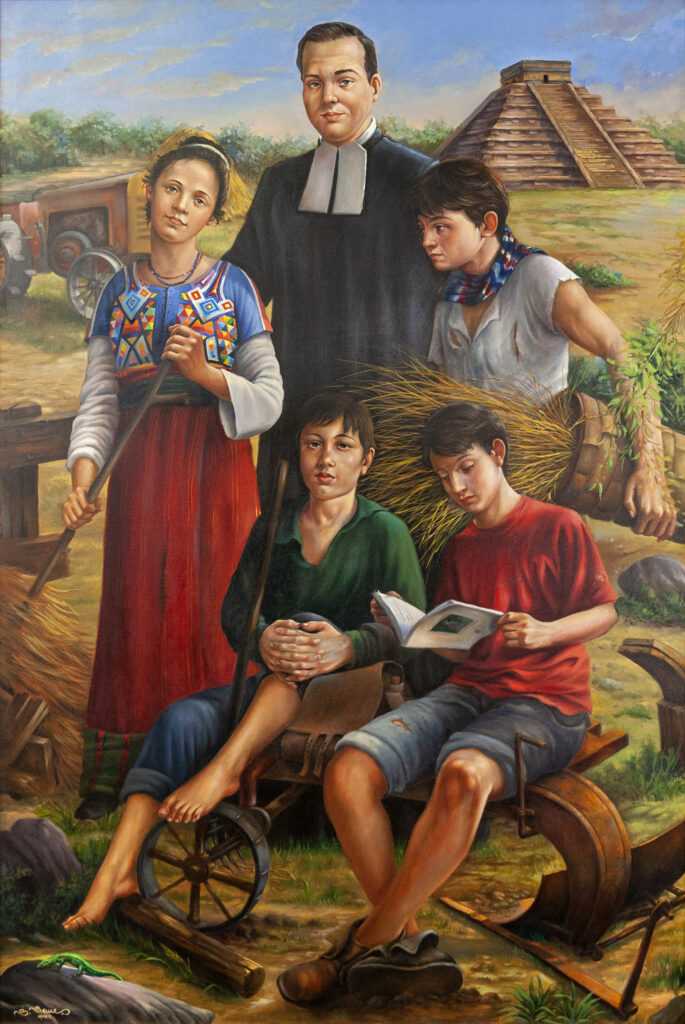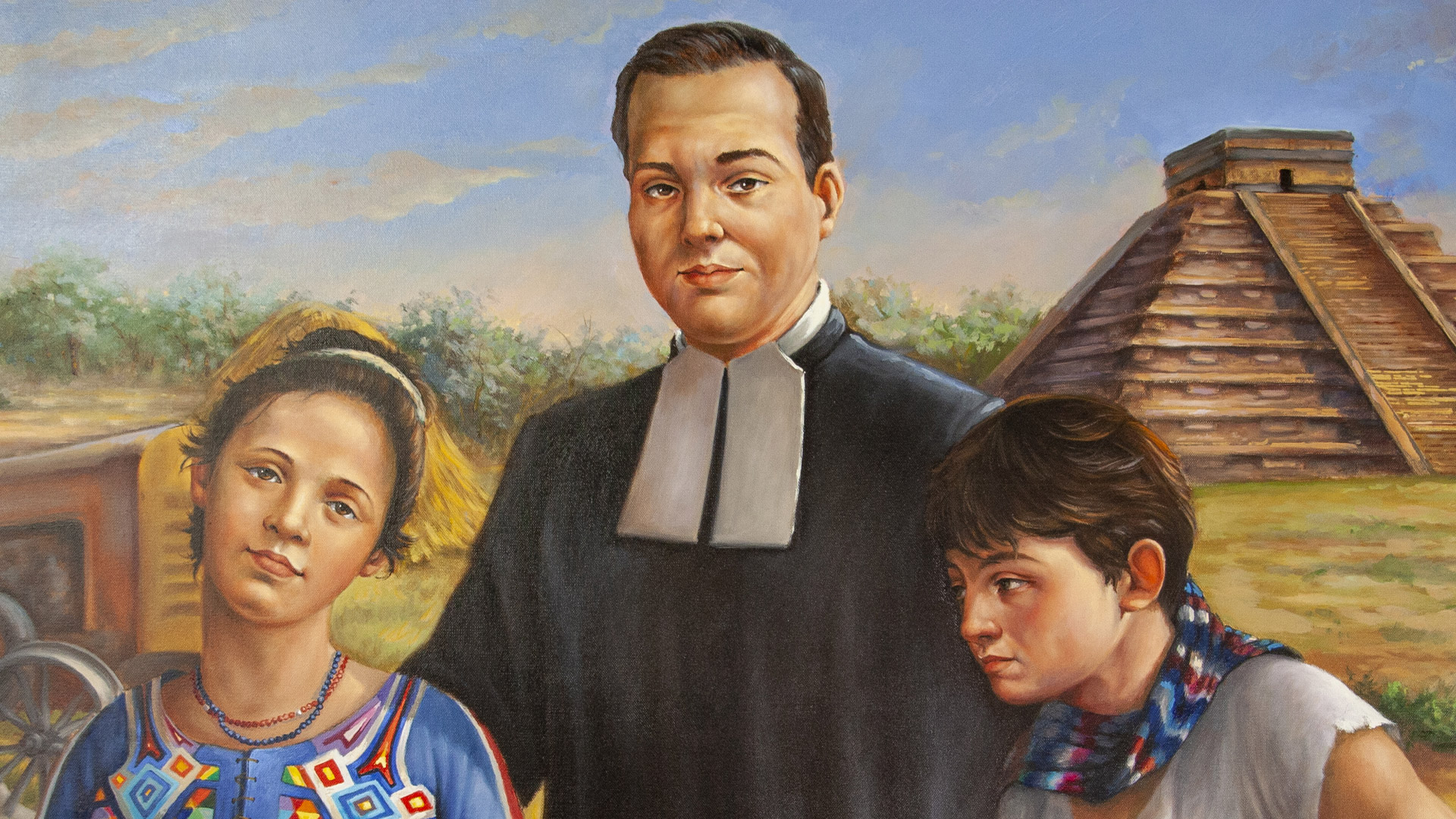A BROTHER WHO MADE HIMSELF…HEARD
Yes, because the Brother you will read about here stood out for his infectious laugh. The reason we write about him, however, is not because of his resounding laugh, but because he made himself heard in the strongest and most beautiful way in the Church and particularly in the Lasallian world. Raised to the glory of the altars in December of last year, he is Brother James Alfred Miller, the first Brother from the United States to be beatified in Guatemala.
A beautiful painting has been done of the Brother that we would like to show you.
The artist is Salvatore Seme. Born in Torre del Greco (Naples) in 1976, he showed a natural inclination for drawing since childhood. It can be said that “Good blood does not lie” because his father Luigi, in turn, known as a good landscape artist, has his views rightfully included among the practioners of that storied phenomenon of small art canvases immortalizing picturesque views of suggestive Neapolitan landscapes. It was Luigi who taught Salvatore the first elements of drawing, which the young boy then perfected first at the Art Institute of Torre del Greco and then at the Academy of Fine Arts in Naples. Participation in collective exhibitions made him better known and some important positive observations brought him to the attention of critics. In this way, he created works for some churches that made him known as a master in the field of religious art. As a result, he was chosen to paint the panels of the Luminous Mysteries to complement the mysteries of the Rosary that frame the picture of the Virgin Mary in the Shrine of Our Lady in Pompeii.
.
In the painting that we present here, oil on canvas of 150 x 100 cm [ca. 5 x 3 ¼ ft] , the artist represents Blessed Brother James in a large outdoor tableau. Some elements make it possible to identify respectively the place where the group is located and the activity that the characters represented perform.
The first element seen in the upper right: a Mayan pyramid. The Mayan civilization occupies a fundamental place in the history of Guatemala. Flourishing for many centuries, it has scattered almost everywhere incredible remains that continue to fascinate. Near Huehuetenango, the city where our Blessed lived, are found the temples of Zaculeu, which was the capital of the Mayan kingdom of Mam.
The second element is the most imposing part of the painting: the peasant world, with the plow on which the two boys sit in the foreground, the basket of wheat carried by the young man to the left of the Blessed, and the girl holding a rake and wearing a multicolored blouse (huipil), typical of Guatemala.
The third element: the boy in the lower right perusing a book. This detail may apparently seem out of place, but the artist also wanted to insert it to underline the intellectual commitment to which the boys of the Center were called. The full growth of an individual cannot do without culture, a fundamental formative aspect, which is learned mainly in books. Study, in addition to learning, promotes the balanced and full development of the individual’s personality, teaches ways of thinking, of expressing oneself, and of living that characterize any human group.
Finally, the whole scene is dominated by the serene and reassuring figure of Brother James in a habit that makes him immediately recognizable as a religious of the Brothers of the Christian Schools. That habit was not inserted randomly and would indeed be out of place and uncomfortable in the countryside, if it were not for the fact that it represents the religious character of the painting. Brother James was in Huehuetenango with those indigenous boys precisely because he was a religious who carried out his educational work in favor of the most neglected in society. The Blessed, coming from a family that owned a farm, among other things, always remained tied to his origins and his passion for manual and agricultural work, in particular, never left him.
Finally, there is another detail worthy of note and that is the serenity of the Blessed’s face. Here his proverbial vivacity and energy seem to have disappeared somewhat, his resounding laughter diluted by the awareness of the noble apostolic work in favor of those poor people whom he loved and by contact with God who asked for the joyful sacrifice of his life.
Now, I think the reader will ask a few questions.
.
The first: What was an American from very northern Wisconsin doing in the Guatemala of the ancient Mayas?
To understand the reason for the arrival of Brother James in Guatemala and, even before him, of the American Brothers in lands that had little to do with them in terms of language and customs, one must refer to the 1966 General Chapter of the Brothers of the Christian Schools. This General Chapter concretely put into practice the exhortations of the Second Vatican Council one of which was the educational service to the poor. Consequently, the US Religious District of Saint Louis chose for its “mission” two of the poorest countries in Central America, Nicaragua and Guatemala.
Brother James was part of that District. In 1969, he was 25 years old and had just professed perpetual religious vows when he asked to go on “mission”. His request was honored and he was a “missionary” in both countries. From 1969 to 1980, he was in Nicaragua and from 1981 to February 13, 1982 in Guatemala, at the Centro Indigena La Salle in Huehuetenango, one of the many free institutions created specifically for indigenous youth, the poorest of the poor. To be admitted to the centers young people had to come from an agricultural background, speak one of the indigenous dialects, and commit themselves to return to their place of origin once the program ended. The boys were welcomed free of charge at the Center and had regular classes in the morning at the Brothers’ Colegio La Salle, and then technical-practical courses in agronomy and livestock care at the San José experimental farm set up for this purpose. This latter was located just outside the city. The aim was to provide these young people, once they returned to their home areas, with a deeply valuable set of religious, civil and manual skills capable of replacing the non-indigenous teachers who often showed little appreciation for the local culture. Above all, it was for them to have as much impact as possible on the moral, cultural, civil, religious and material life of their communities. In other words, indigenous leaders were prepared for the rural areas to which they would return after their school experience.
A second question: why did people who were trying only to better Guatemalan society even risk their lives?
Briefly, it can be said that during the bloody civil war that devastated the country from 1960 to 1996, led by the right-wing military dictatorship against the left-wing guerrilla groups and the indigenous peoples whom the government believed supported the rebels, those who defended the rights of the poor were considered as communists to be eliminated in any way. It was the time of the Seguridad Nacional on the one hand and the misunderstood Theology of Liberation on the other. Years of hatred, destruction, suffering, added to the endemic misery of the country, especially in rural areas. Those who preached justice and equality for the poor also paid the price. The Brothers, especially those who welcomed the indigenous people, were repeatedly threatened: a bomb was detonated in the Centro Indigena Santiago in Guatemala City as a warning; in Huehuetenango, a brother of Brother Gustavo Bracamonte was kidnapped. It was never known what happened to him. Following this episode Brother Gustavo was sent elsewhere. The Brothers nevertheless continued their apostolic work with quiet self-assurance, but we must also think with some fear. In this climate, Brother James arrived at the beginning of 1981. To those who asked him: “Jim, aren’t you afraid of going to Guatemala at this time?” He replied, “I don’t think about it at all. There is so much to do. You can’t waste your energy thinking about what could happen to you.”
Those who shot him on that afternoon of February 13, 1982, and even more so the ones who sent them, were thinking otherwise. That sturdy young brother, full of life and laughter, just arrived, was an affront. “They must have wondered – we threaten to kill them all and they send a new one, young and strong! We must make them pay!” They had not reckoned with the greatness of Christ’s apostles. “God knows why He called me to Guatemala when so many friends and relatives urged me to leave for my peace and safety. I have been a Brother of the Christian Schools for about twenty years and the attachment to my vocation grows ever more deeply as I work in Central America. I pray God to give me the grace and strength to serve him faithfully among the poor and oppressed of Guatemala. I entrust my life to His providence; I trust in Him.” This was what Brother James wrote to a friend a few months before the tragic end on the afternoon of February 13, 1982.
It was a true martyrdom, recognized by the Church and solemnly proclaimed in Huehuetenango on December 7, 2019. A moving detail: out of need for space and equipment the beatification took place in the sports facilities of the large Colegio La Salle (2,300 students), where Brother James had taught in the one year of his stay in Huehuetenango. Perhaps the only time in the history of beatifications!
Brother Rodolfo Cosimo Meoli
Postulator General
Rome, 05 July 2020
Brother Nicolas Capelle’s a very fine point of view
“In a landscape of warm, rural colours, He is there, quiet, moderately confident but watchful: modern watchman of the Temple of Zaculeu, he senses the enemy lurking around a youthful force with limited strength, but determined to take their joyful part in the building up of a fraternal and friendly country




